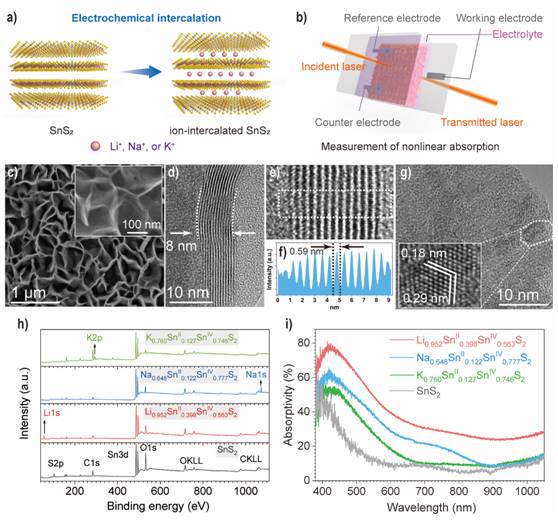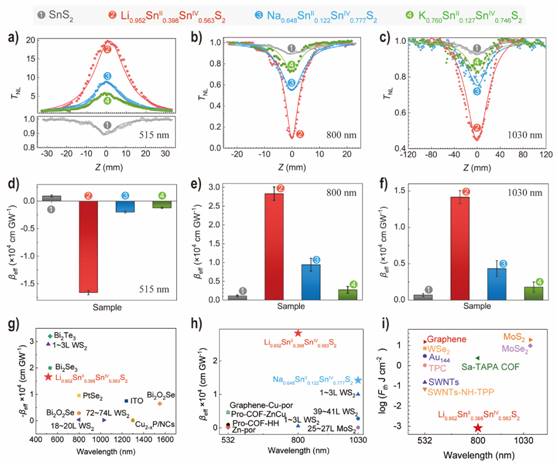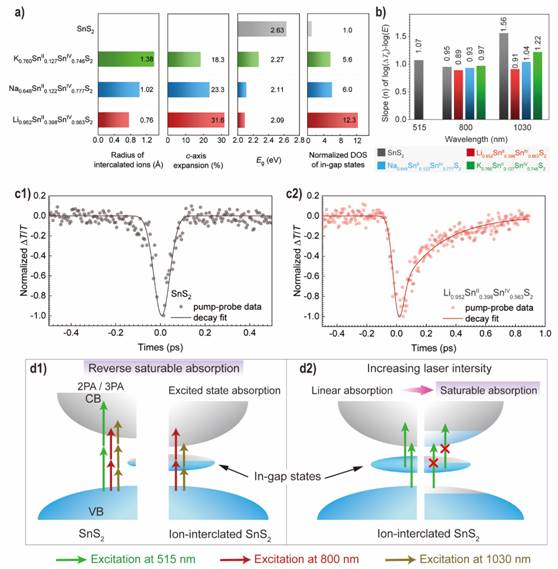Nonlinear optics represent the key basic optical processes in the application of ultra-intense lasers, including laser pulse generation, non-linear optical imaging, optical switching and optical limiting. It is of important scientific value and practical application prospect to innovatively develop high-performance non-linearoptically absorptivematerials. 2D semiconductor materials have great application potential among nonlinear optical materials. However, high-performance 2D nonlinear optical nanomaterials are generally synthesized in demanding conditions with a low yield. It is urgent to explore out an efficient and convenient strategy to innovatively develop high-performance nonlinear optical materials.Professor Huang Zhipeng and Academician Zhang Chi's research team recently reported their research outcomes by publishing a paper (DOI:10.1002/adfm.202106930) titled Giant Nonlinear Optical Absorption of Ion-Intercalated Tin Disulfide Associated with Abundant In-Gap Defects inAdvanced Functional Materials, an important journal on materials science. The researchers proposed an electrochemical ion-intercalation strategy for the first time to quickly and efficiently regulate the nonlinear absorption performance of 2D materials. In the electrochemical intercalation of a series of alkali metal ions (Li+, Na+, K+) into SnS2nanosheets, they found that all ion-intercalated samples exhibit remarkably enhanced nonlinear absorption; among them, Li-intercalated SnS2(Li0.952SnII0.398SnIV0.563S2) possesses the optimized performance, exhibiting saturable absorption for the femtosecond laser excitation at 515 nm (βeff: -1.7 × 104cm GW-1), while the prominent reverse saturable absorption with the femtosecond laser excitation at 800 nm (βeff: 2.8 × 104cm GW–1) and 1030 nm (βeff: 1.4 × 104cm GW–1).According to the spectroscopy study, ion-intercalation can introduce abundant in-gap defects in 2D materials, which intensifies the Pauli-blocking effect and therefore promotes the saturable absorption under the 515 nm laser excitation while acting as an effective excitation pathway to facilitate excited-state absorption and accordingly improve reverse saturable absorption for 800 and 1030 nm laser.Their research not only reveals ion-intercalated materials as novel high-performance nonlinear optical materials, but also provides an effective strategy for developing high-performance nonlinear optical materials.

Figure 1.(a) SnS2intercalation model, (b) Schematic diagram of performance research setup, (c-g) Morphological and structural characterization of SnS2and XPS (h) and linear absorption spectroscopic characterization (i) of intercalated samples.
In a three-electrode configuration, Berndtite 2T SnS2was used as the matrix material for the electrochemical ion intercalation under this research, and the gap between adjacent layers served as an open channel for ion diffusion. TEM and XPS spectroscopic characterization demonstrated the successful intercalation of alkali metal ions, and varied volume expansion of host SnS2at different radii for ion intercalation and resulting difference in defect levels. Therefore, the band gap of SnS2can be effectively manipulated by changes in ion-intercalations, and the absorption edge of SnS2is subject to a gradual red shift as the radius for ion intercalation decreases.

Figure 2.(a-c) Z-scan curves of SnS2and intercalated samples at different excitation wavelengths, nonlinear absorption coefficients (d-f) and comparison with other inorganic semiconductor materials (g-h).
In a wavelength range (515-1030 nm), the optical nonlinearity of SnS2can be reversed or modulated by ion intercalation. Meanwhile, the modulation effect of optical nonlinearity is closely related to the ion-intercalation radius. The ion intercalation with a smaller radius can result in better performance of the corresponding samples, particularly a nonlinear absorption performance superior to most inorganic semiconductors reported in the literature.

Figure 3.(a) Relationship between nonlinear absorption coefficient and electrochemical intercalation time, (b) Regulation process of ion intercalation/deintercalation cycle of nonlinear absorption coefficient, (c) Time stability of nonlinear absorption performance of intercalated samples.
In addition, the ion intercalation strategy can be applied to continuously and dynamically regulate the nonlinear optical response of SnS2, and the electrochemical ion intercalation was demonstrated as a convenient method to modulate the optical nonlinear performance of SnS2by simply changing the charge/discharge time. Moreover, the ion-intercalated SnS2was proven stable enough in the air to serve as a kind of high-performance off-line nonlinear optical material.

Figure 4.(a) Relationship of c-axis expansion, band gap and density of defect states of intercalated samples with radius of ion-intercalation, (b) Slope of relationship between nonlinear absorption amplitude and laser excitation intensity, (c1, c2) Pump-probe curve, (d1-d3) Mechanism of defect-regulating nonlinear absorption process.
The density of states of in-gap defects is also related to c-axis lattice expansion (radius of alkali metal ion). The smaller the radius of alkali metal ions, the larger the lattice expansion of intercalated samples along the c-axis and the more the states with in-gap defects. In-gap defects intensify the Pauli-blocking effect and therefore promote the saturable absorption under the 515 nm laser excitation, and defect states act as an effectiveexcitation pathway to promote reverse saturable absorptionunder 800 nm and 1030 nm laser excitation.
The research work was supported by the National Natural Science Foundation of China as a key project and general project, the Program for Innovative Research Team in University by the Ministry of Education, the Program for Innovative Research Team in Key Fields by the Ministry of Science and Technology, and Key Projects of Science and Technology Innovation Plan of Shanghai Municipal Education Commission. Professor Huang Zhipeng and Academician Zhang Chi contributed as the co-corresponding authors of the paper, and Diao Mengjuan, a doctoral candidate and Dr. Li Hui, a postdoctoral candidate as the co-first authors of the paper.